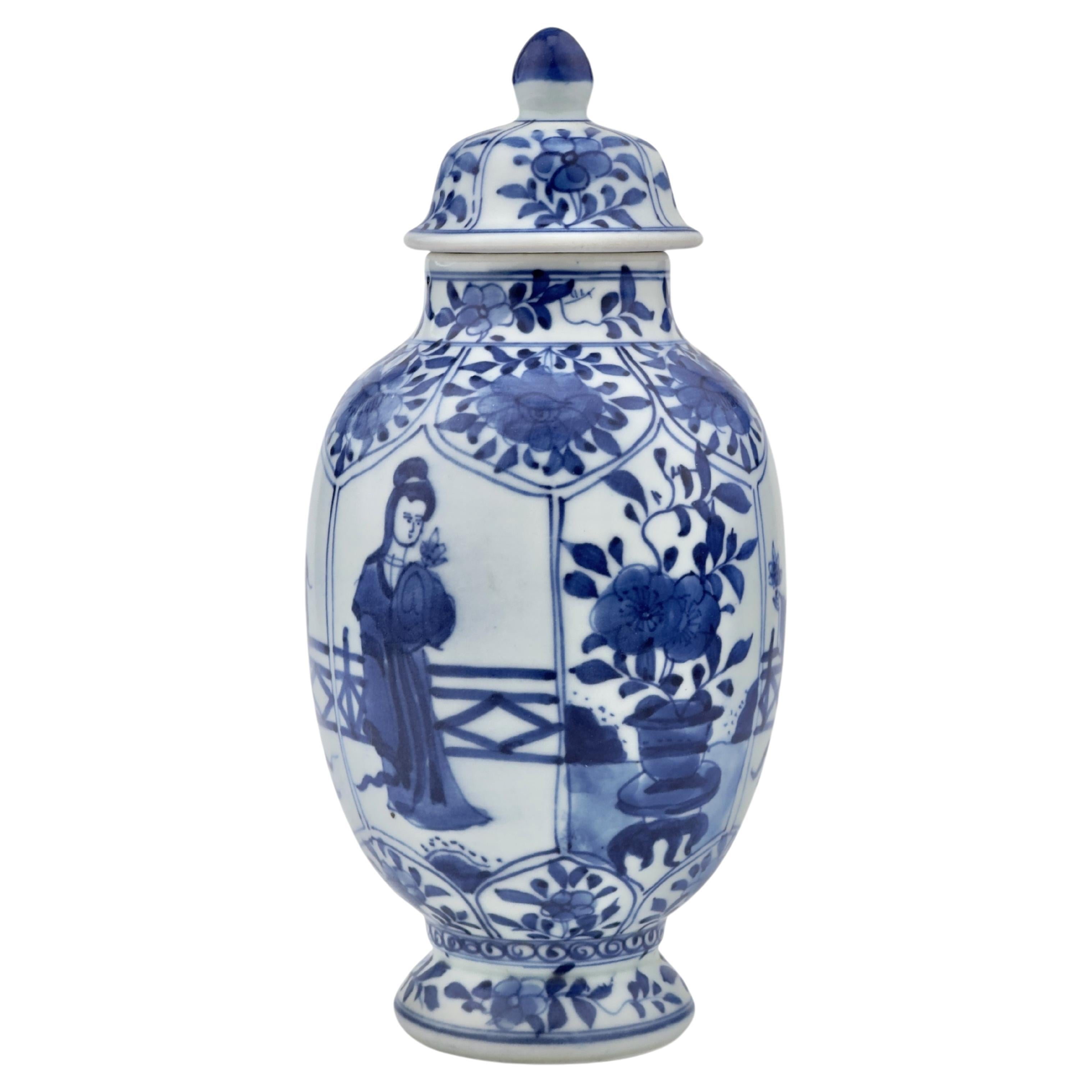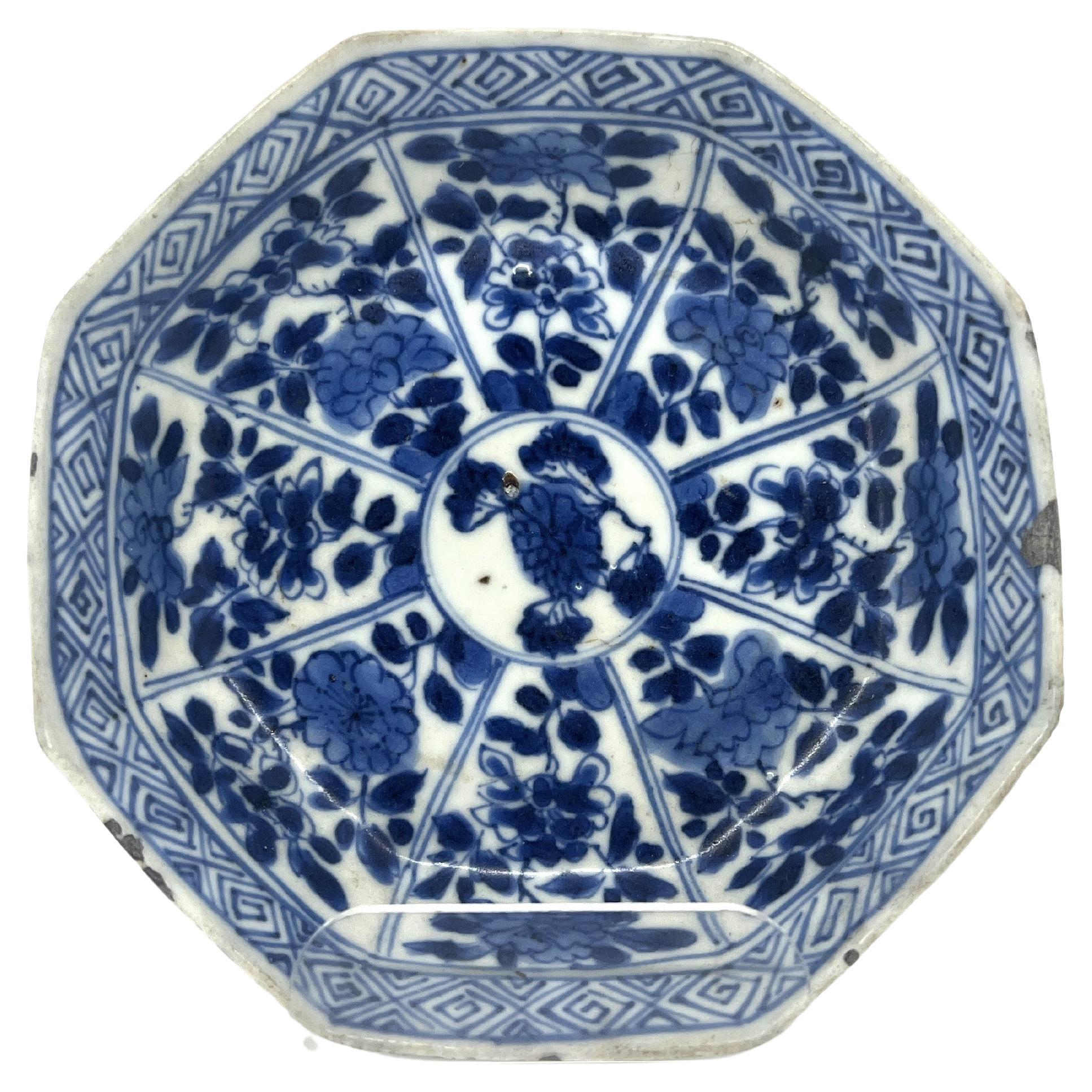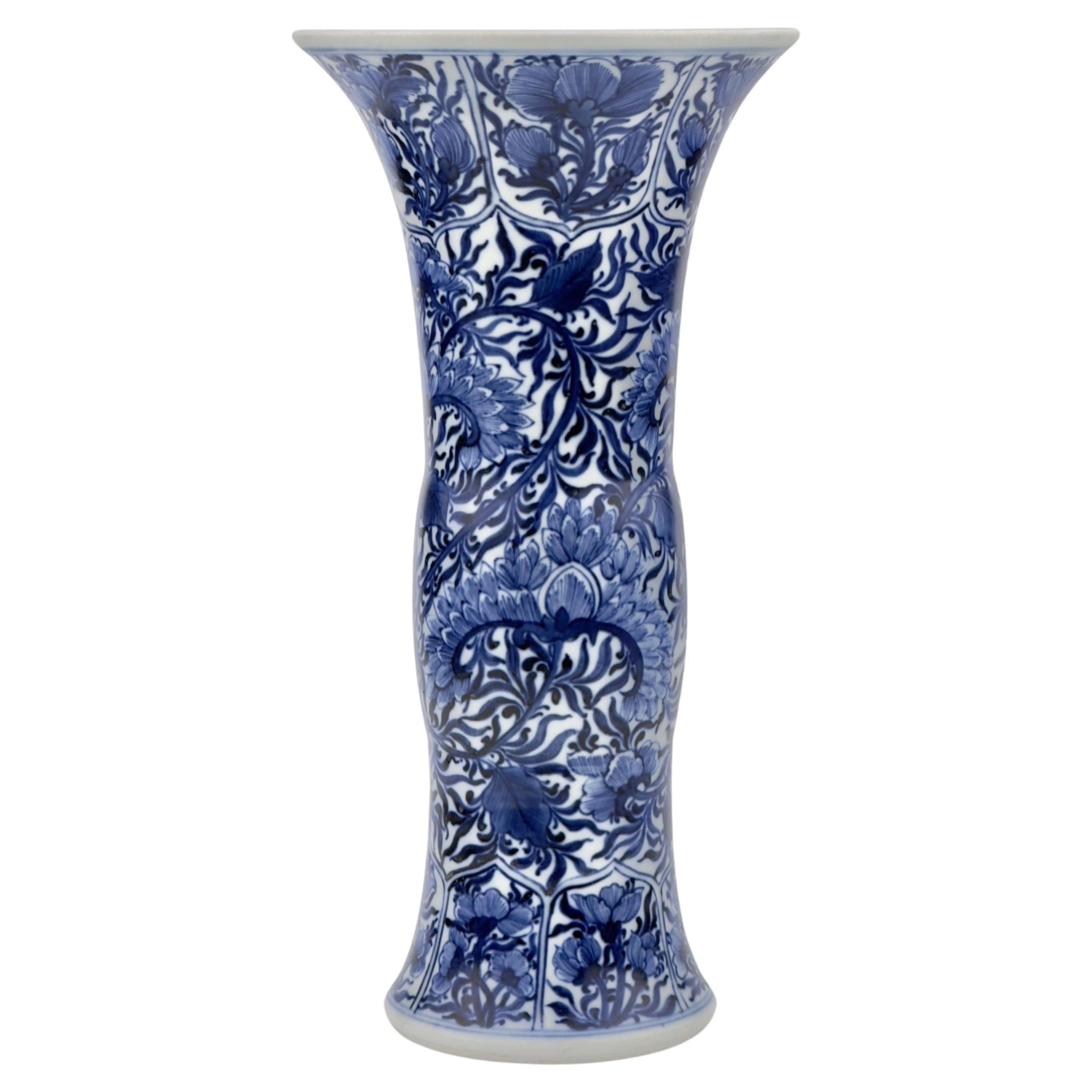Items Similar to Blue and White Saucer, Qing Dynasty, Kangxi Era, Circa 1690
Want more images or videos?
Request additional images or videos from the seller
1 of 12
Blue and White Saucer, Qing Dynasty, Kangxi Era, Circa 1690
About the Item
It features a complex design with a central circular motif surrounded by eight petal-like sections, each intricately adorned with various botanical and geometric patterns, creating a symmetrical arrangement.
The number 8 in Chinese culture is associated with prosperity and is considered very auspicious. This may reflect the traditional Chinese cosmological concept of the "Bagua," which are eight trigrams used in Taoist philosophy to represent fundamental principles of reality, seen in various aspects of Chinese culture, including the I Ching and Feng Shui.
The central circle with radiating petals is also a representation of perfect geometric harmony, reflecting the balance and unity which are key elements in Chinese aesthetics. The use of symmetry and balance is seen as a way to represent the harmony of the universe.
Period : Qing Dynasty, Kangxi Period
Production Date : 1690-1699
Made in : Jingdezhen
Destination : Netherland
Found/Acquired : Southeast Asia , South China Sea, Vung Tau ship
Size : 12.5cm (Diameter)
Condition : Excellent
Reference : Double checked with reference to the original catalogues
1) Christies Amsterdam 1992 - Vung Tau Cargo / Christies
2) Qing Dynasty Export Blue and White(淸代外销靑花瓷) - Vung Tau Cargo Catalogue / Guangxi Fine Art Publishing House
3) Asian Ceramic Found along Maritime Silk Route / National Maritime Museum of Korea
* Vung Tau Cargo Porcelain
The Vung Tau Cargo was found in the South China Sea off the islands of Con Dao about 100 nautical miles (185 km; 115 mi) from Vung Tau, Vietanam. The ship was of a lorcha boat—a vessel with Cantonese/Chinese and Portuguese/European influences that has been dated to about 1690. It was found by a fisherman who had picked up numerous pieces of porcelain from the ship while fishing. Sverker Hallstrom identified the ship and its cargo in 1990. Australian diver Michael Flecker took charge of the archaeological aspect of the excavation. An analysis of its cargo deduced that the ship was bound from China to Jakarta, Indonesia, where the porcelain would have been purchased by the Dutch East India Company for trans-shipment to Holland, Europe as a commercial trade goods.
About the Seller
New to 1stDibs
Joined in the past six months.
4.5
Vetted Seller
These experienced sellers undergo a comprehensive evaluation by our team of in-house experts.
Established in 1999
1stDibs seller since 2023
Typical response time: 1 hour
- ShippingRetrieving quote...Ships From: seoul, Korea South
- Return PolicyA return for this item may be initiated within 10 days of delivery.
More From This SellerView All
- Blue And White Vase, Qing Dynasty, Kangxi Era, Circa 1690Located in seoul, KRThe painting features a typical Kangxi blue and white style depiction of a female figure. Period : Qing Dynasty, Kangxi reign Production Date : 1690-1699 Made in : Jingdezhen Destination : Amsterdam Found/Acquired : Southeast Asia , South China Sea, Vung Tau Ship Reference : Double checked with reference to the original catalogues 1) Christies Amsterdam 1992 - Vung Tau Cargo...Category
Antique 1690s Chinese Qing Antiquities
MaterialsCeramic
- Mid-size Octagonal Saucer, Qing Dynasty, Kangxi era, circa 1690.Located in seoul, KRThe design features a central medallion surrounded by eight panels, each intricately painted with traditional Chinese botanical and floral motifs. The number 8 in Chinese culture is associated with prosperity and is considered very auspicious. This may reflect the traditional Chinese cosmological concept of the "Bagua," which are eight trigrams used in Taoist philosophy to represent fundamental principles of reality, seen in various aspects of Chinese culture, including the I Ching and Feng Shui. The central circle with radiating petals is also a representation of perfect geometric harmony, reflecting the balance and unity which are key elements in Chinese aesthetics. The use of symmetry and balance is seen as a way to represent the harmony of the universe. Period : Qing Dynasty, Kangxi Period Production Date : 1690-1699 Made in : Jingdezhen Destination : Netherland Found/Acquired : Southeast Asia , South China Sea, Vung Tau...Category
Antique 1690s Chinese Qing Antiquities
MaterialsCeramic
- Blue and White Baluster Vase, Qing Dynasty, Kangxi Era, Circa 1690Located in seoul, KRThe baluster shaped vase rising from a splayed foot to a short waisted neck, decorated in underglaze blue with flower blooms borne on leafy stems. Period : Qing Dynasty, Kangxi reign Production Date : 1690-1699 Made in : Jingdezhen Destination : Amsterdam Found/Acquired : Southeast Asia , South China Sea, Vung Tau...Category
Antique 1690s Chinese Chinoiserie Antiquities
MaterialsCeramic
- Ancient Gu Shape Blue And White Vase, Qing Dynasty, Kangxi Era, Circa 1690Located in seoul, KRAn attractive gu vase hand painted in cobalt blue with typical kangxi floral painting. Period : Qing Dynasty, Kangxi Period Production Date : 1690-1699 Made in : Jingdezhen Destination : Netherland Found/Acquired : Southeast Asia , South China Sea, Vung Tau ship Reference : Double checked with reference to the original catalogues 1) Christies Amsterdam 1992 - Vung Tau Cargo / Christies 2) Qing Dynasty Export...Category
Antique 1690s Chinese Qing Antiquities
MaterialsCeramic, Porcelain
- Ancient Gu Shape Blue And White Vase, Qing Dynasty, Kangxi Era, Circa 1690Located in seoul, KRAn attractive GU vase hand painted in cobalt blue with typical kangxi flower panels painting separated by lined borders. Period : Qing Dynasty, Kangxi Period Production Date : 1690-1699 Made in : Jingdezhen Destination : Netherland Found/Acquired : Southeast Asia , South China Sea, Vung Tau ship Size : 14cm (Height) x 8.5cm (Diameter) Condition : Excellent Reference : Double checked with reference to the original catalogues 1) Christies Amsterdam 1992 - Vung Tau Cargo / Christies 2) Qing Dynasty Export Blue and White from Vung Tau Cargo(淸代外销靑花瓷) / Guangxi Fine Art Publishing House 3) Asian Ceramic Found along Maritime Silk Route / National Maritime Museum of Korea * Vung Tau Cargo Porcelain...Category
Antique 1690s Chinese Qing Antiquities
MaterialsCeramic
- Kendi Blue And White, Qing Dynasty, Kangxi Period, C 1690Located in seoul, KRThe Kendi is decorated with cobalt blue underglaze depicting flowers and a mythical bird, reflecting the artistic finesse and symbolic expressions of the era. These designs often carry symbolic meanings, with birds sometimes representing immortality or spiritual transcendence in Chinese mythology. The Kendi's form, with a bulbous body and spout for drinking, is a traditional vessel style in Asia, valued for both its functionality and aesthetic appeal. Period : Qing Dynasty, Kangxi Period Production Date : 1690-1699 Made in : Jingdezhen Destination : Netherland Found/Acquired : Southeast Asia , South China Sea, Vung Tau ship Reference : Double checked with reference to the original catalogues 1) Christies Amsterdam 1992 - Vung Tau Cargo / Christies 2) Qing Dynasty Export...Category
Antique 1690s Chinese Qing Antiquities
MaterialsCeramic
You May Also Like
- Chinese porcelain sitting dog, Dehua, Qing Dynasty, Kangxi EraLocated in Delft, NLChinese porcelain sitting dog, Dehua, Qing Dynasty, Kangxi Era Small Chinese porcelain dog, China, 18th century Dehua, Qing dynasty (1644-1911...Category
Antique Early 18th Century Chinese Antiquities
MaterialsPorcelain
- Antique Qing Dynasty Blue and White Chinese Porcelain CenserLocated in Brea, CAQing dynasty Kang XI blue and white Chinese porcelain censer with a design of "Antiques" and auspicious objects, the base in clear glaze and the mouth...Category
Antique Early 18th Century Chinese Qing Antiquities
MaterialsPorcelain
- Qing Dynasty Pair of Chinese Blue and White Octagonal Porcelain Dragon PlatesLocated in Brea, CAQing Dynasty pair of antique 19th century Chinese blue and white octagonal dragon porcelain plates decorated with four clawed coiling ...Category
Antique Early 19th Century Chinese Qing Antiquities
MaterialsPorcelain
- Chinese Export Blue and White "Cranes" Charger Qing DynastyLocated in West Palm Beach, FLA Chinese export blue and white "cranes" charger. Qing dynasty, with a tightly scalloped edge, border of stylized motifs, the center recess representing two cranes in a stylized mar...Category
20th Century Antiquities
MaterialsCeramic
- White Jade Double Gourd Pendant, Qing DynastyLocated in Nova Scotia, NSThis antique nephrite jade double gourd pendant is of the Qing Dynasty and has a fine texture with a glossy luster. It is primarily white with some slight inclusions in the left lower body but in bright light the pendant has a slight green tinge. This lovely jade pendant consists of a smaller gourd on top of a larger one surrounded by vines with smaller hanging gourds. The vines create numerous holes from which to hang the pendant. There are also etchings of stars on the body of the gourds along with tendrils of curling vines. In the Chinese culture, the double gourd is a symbol of fertility and good fortune. Gourds are also associated with Li Tie Guai, one of the eight immortals. This lovely jade pendant was purchased from a private collection along with a magnificent antique Chinese silk...Category
Antique 19th Century Chinese Qing Antiquities
MaterialsStone, Jade
- White Jade Dragon with Pearl Pendant, Qing DynastyLocated in Nova Scotia, NSThis antique Qing Dynasty nephrite jade pendant consists of a dragon with a pearl in its mouth. There is decorative etching on the body, and the head and mouth are well defined. The pendant has a semi-fine texture with a semi-gloss or slightly waxy luster. This lovely piece of jade is white and has a very slight green tinge in certain lighting. In the Chinese culture, the dragon symbolizes prosperity and good fortune, while the pearl is a symbol of wisdom, spiritual energy, and power. The dragon with a pearl is also a common theme in Chinese imagery and is the subject of myth and legend. This lovely jade pendant was purchased from a private collection along with a magnificent antique Chinese silk...Category
Antique 19th Century Chinese Qing Antiquities
MaterialsStone, Jade
Recently Viewed
View AllMore Ways To Browse
Persian Monarch
Evil Dead
Mirrors Europe
Organic Kitchen
Pair Of High Tables
Mid Century Frosted Glass
Wood Top Sofa
Concrete Concrete Chair
Refinished Table
Herman Miller Chair Set
S Wegner
Old Crosses
Desk Office Lacquer
Antiques From 1800s
Asian Seat
Monumental Italian Furniture
Asian Antique Black Furniture
Black And Wood Dining Room Set





